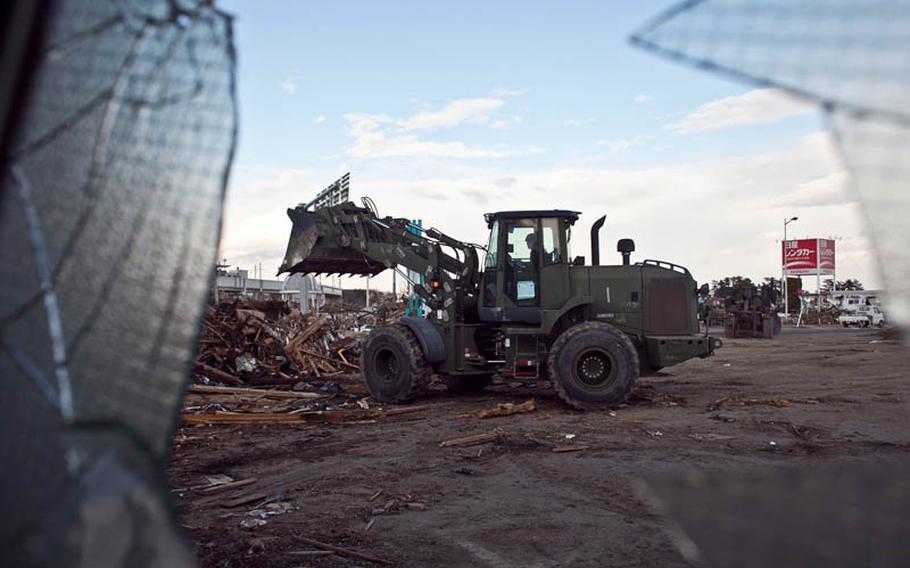Migration
Marines help clear out Sendai Airport after tsunami
Stars and Stripes March 24, 2011

U.S. servicemembers help clear the Sendai Airport in Sendai, Japan, that was severly damaged after the 9.0 earthquake and resulting tsunami. U.S. forces have cleared the runway of hundreds of wrecked cars and other debris enabling the airport to receive humanitarian aid. (Travis J. Tritten/Stars and Stripes)
SENDAI, Japan — Tsuyoshi Sato stood at the Sendai Airport fuel farm Thursday evening as a crew of Marines used heavy chains and a military tow truck to pull a car from a one-story pile of debris.
Sato, 59, was an employee at the fuel area until a tsunami swept through two weeks ago, turning the airport into a tangled swamp of vehicles, dead bodies, crushed buildings and mud that became an international symbol of the destruction in Japan.
The tsunami wedged the tanker trucks used to gas up aircraft around the fuel farm pumps. The damage was so bad and heavy equipment for cleanup so hard to find that owners were ready to give up on restoring the pumps, Sato said.
But Marines deployed to the airport from Camp Fuji began clearing the site Thursday morning. And by early evening, Sato was standing in a clean lot holding up his digital camera to compare earlier photos of the debris-clogged pumps.
“No other companies would be able to do this,” Sato said, motioning to the Marine Corps truck and forklift that was hauling away a vehicle.
Two weeks after one of Japan’s worst disasters, the cleanup at Sendai Airport remains the crowning achievement of U.S. military relief efforts in Miyagi Prefecture, about 200 miles northeast of Tokyo.
It has provided a bright spot for servicemembers eager to help Japan but deployed to an area where requests for direct assistance from the Japanese government have been sporadic and limited, despite widespread suffering among tens of thousands of residents who now live in shelters or are surviving in destroyed neighborhoods.
“How many cars did we pull out? 300?” Staff Sgt. Hugo Roman, 28, asked a group of other CATC Marines after the group finished removing another vehicle at the entrance of the airport Thursday.
Since Sunday, Marines with the Combined Arms Training Center at Camp Fuji had been towing away hundreds of vehicles that were jammed into and around the passenger terminal of the Sendai Airport.
The work has helped convert the airport from a disaster site to a key entry point for relief supplies such as kerosene to heat hospitals, water and blankets. Those supplies have been passed on to Japanese authorities for distribution, and in some cases, have been delivered by the U.S. military to shelters and other areas of need.
The story of the Sendai Airport could have gone differently. The scale of destruction following the earthquake and tsunami had nearly caused the Japanese to give up on the airport, said Robert Eldridge, deputy assistant chief of staff for the Marine Corps Bases Japan Community, Policy, Planning and Liaison Office.
“If you were there and you saw it, you would have written it off, too,” said Eldridge, who was among a small group of military officials who first met with Japanese officials to assess the damage just days after the disaster struck.
But some initial clearing work by U.S. special forces helped encourage the Japanese to mobilize vehicles and cleanup crews, he said.
“They did a lot of the heavy work and we provided the spiritual support,” Eldridge said.
Capt. Joseph Booker, of the 320th Special Tactics Squadron out of Kadena Air Base on Okinawa, was among the first team of Air Force special forces that arrived at the airport March 16 in Humvees from a nearby airdrop in Matsushima.
“The Japanese had actually written this airport off,” Booker said. “There were cars scattered everywhere just like the satellite imagery indicated.”
Within about three hours, the squadron had cleared 5,000 feet of runway, enough for C-130s to land, he said. By the end of the week, the Air Force was landing the larger C-17 Globemasters at the Sendai Airport.
The Marines from Camp Fuji arrived on Sunday.
“Immediately upon getting here we started clearing cars and it fired up the airport staff to start working,” said Col. Craig Kozeniesky, commander of the Combined Arms Training Center and now head of the cleanup effort at the airport.
Now, the terminal area is cleared and the long-term parking area is about 80 percent clear, Kozeniesky said.
Marines and other servicemembers in Miyagi Prefecture have been eager do more relief work for victims of the disaster. But they’ve had limited opportunities.
There are about 107,000 people living Miyagi shelters where food and other supplies often run short, according to the prefecture government. Tens of thousands more still live in areas partially destroyed by the massive waves that struck the coast here, killing 5,889.
Meanwhile, 19 makeshift morgues have sprung up across the prefecture to hold the 744 unclaimed bodies found in the disaster zones, the prefecture said.
Supplies brought in through Sendai Airport have reached victims in the area, mostly after being distributed by Japanese authorities. The arrangement has kept many servicemembers from the face-to-face relief work they hoped for.
The CATC Marines wanted so much to do more that they resorted to running a fuel convoy hours north to Iwate Prefecture, where the Air Force in Misawa has been providing relief for over a week, Kozeniesky said.
Four heavy trucks distributed 140 barrels of kerosene to the area there and Kozeniesky said he is pressing to make such convoys a regular task for the Camp Fuji Marines.
But it is still unclear whether that will happen. Any regular aid convoys will depend on requests from the Japanese government, which has so far only made limited requests for help.
“There is so much need,” Kozeniesky said. “I think we can step off and do more and we are pushing aggressively to do that.”